#Alberta Provincial Highway No. 1
Video
Peaks of the Sawback Range (Black & White) by Mark Stevens
Via Flickr:
A roadside pulloff along Trans-Canada Highway 1 with a view looking to the northeast. There was nothing specific in this image that drew me in; it was just the general look of the entire setting with the nearby hillside of trees and then snowcapped mountain peaks off in the distance with blue skies above. One of the peaks I was able to identify was The Finger in image middle left. I found converting to Black & White also brought out a much richer total contrast in not just the rocks of the mountain peaks but also with the nearby evergreen trees.
#Alberta Highway 1#Alberta Provincial Highway No. 1#Banff National Park#Black & White#Blue Skies with Clouds#Canadian Rockies#Capture NX2 Edited#Central Front Ranges#Color Efex Pro#Day 2#Evergreens#Hillside#Hillside of Trees#Looking NE#Mountain#Mountains in Distance#Mountains off in Distance#Nature#Nikon D800E#Project365#Roadside Pulloff#Sawback Range#Sawback-Slate Ranges#Snowcapped#The Finger#Trans-Canada Highway#Trans-Canada Highway 1#Trees#Alberta#Canada
8 notes
·
View notes
Text


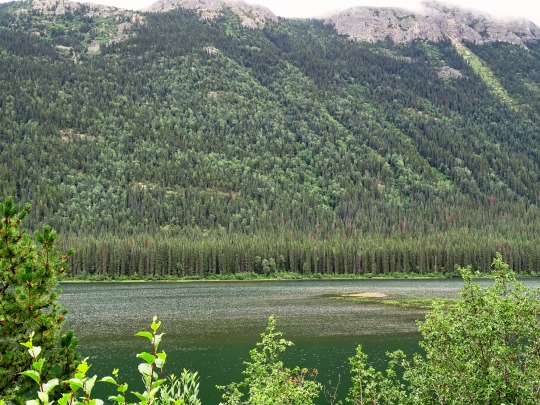
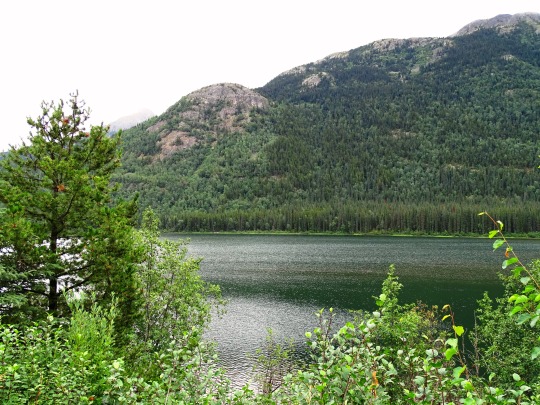



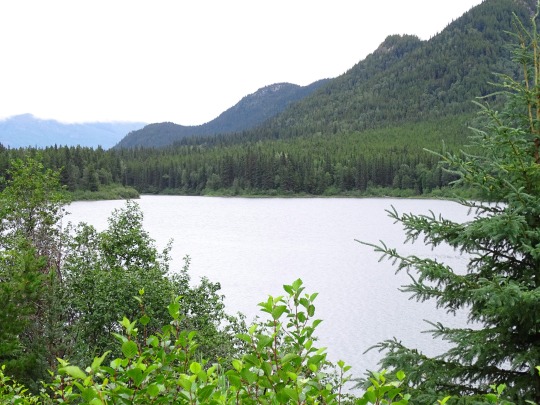


Pinetree Lake, BC (No. 1)
The British Columbia Interior, popularly referred to as the BC Interior or simply the Interior, is a geographic region of the Canadian province of British Columbia. While the exact boundaries are variously defined, the British Columbia Interior is generally defined to include the 14 regional districts that do not have coastline along the Pacific Ocean or Salish Sea, and are not part of the Lower Mainland. Other boundaries may exclude parts of or even entire regional districts, or expand the definition to include the regional districts of Fraser Valley, Squamish–Lillooet, and Kitimat–Stikine.
Home to just under 1 million people, the British Columbia Interior's 14 regional districts contain many cities, towns, airports, and associated regional, provincial, and national parks connected by the province's highway and railway network. The region is known for the complexity of its landforms, the result of millions of years of tectonic plate movements. The ecology of the region is dominated by temperate coniferous forest with patches of alpine tundra found atop its numerous mountain ranges.
The Northern Interior Plain is a continuation of the interior plain that takes in nearly all of Alberta and southern Saskatchewan and Manitoba. It extends from Monkman Provincial Park and Tumbler Ridge in the south, to Hudson's Hope and the Williston Lake in the west, to Fort St. John and Charlie Lake in the north. The term is used to mean the whole of the Northeastern Interior east of the Rockies, including Fort Nelson and other parts of the Liard drainage, and before W.A.C. Bennett Dam included the upper Peace River through its canyon between Finlay Forks and Hudson's Hope.
Source: Wikipedia
#Pinetree Lake#original photography#travel#vacation#tourist attraction#landmark#landscape#countryside#nature#Canada#summer 2023#fir#the North#cityscape#forest#woods#flora#British Columbia#wildflower#Stikine Highway#clouds#British Columbia Highway 37#Skeena Region#lake shore#Skeena Country#British Columbia Interior
12 notes
·
View notes
Text
Sunday
Really, really long drive today. Over 500 miles to Dinosaur Provincial Park in Alberta.
At 3:52am, I woke up to catch a glimpse of the sunrise. At 4:55am, I did Wordle and thought about getting out of bed. I don’t know how well I would do in the land of the midnight sun.

3:52am

4:55am
The Delta Hotel did well by us. We had a very nice suite, access to the concierge lounge, and complementary breakfast. All those days of business travel still pay off when traveling outside of the USA.
As we made our way out of town we passed Rothwell Street and saw a gray partridge running through a parking lot. How could the day get any better!

Need I say more…
We drove an hour down Trans-Canada Highway 1 and stopped in Moose Jaw to check out the town. Sunday mornings is not the best time to see how vibrant a town might be. Needless to say, it was dead. However, we could see that there was a lot going on in town. All the storefronts were full, there were plenty of bars and restaurants, just nothing was open on Sunday at 9am.

Quiet Sunday morning in Moose Jaw.
We rolled down the highway.
Next stop was Swift Current for lunch. Then we passed through Medicine Hat. Along the way, the flat farmland of Saskatchewan turned into rolling hills. Then it flattened a little as we came into Alberta. We saw mule deer, pronghorn, and the occasional suicidal rodent. We saw miles of rapeseed (canola), legumes, oats, and other crops. We saw major mining operations, miles of power transmission lines, pump jacks, solar panels, and windmills. And we saw cyclists miles from nowhere riding bikes that were fully loaded with gear. Those crazy cyclists!

The yellow crop is rapeseed (canola).

Pump jack.
We rolled into Dinosaur Provincial Park around 4:30pm. The Park is actually in a canyon which was a surprise to us. We were driving along and suddenly dropped a few hundred feet into the park entrance and visitors center.

Dinosaur PP behind us.
The park is wide open for exploration. The areas on the fringes the park are restricted to authorized persons due to the abundance of fossils. Before we leave, we have a tour within the restricted area!
The campground is quite active. The park as a variety of programs for visitors, especially kids. We sat in on the Dinosaur Trivia contest which was fun for all ages.
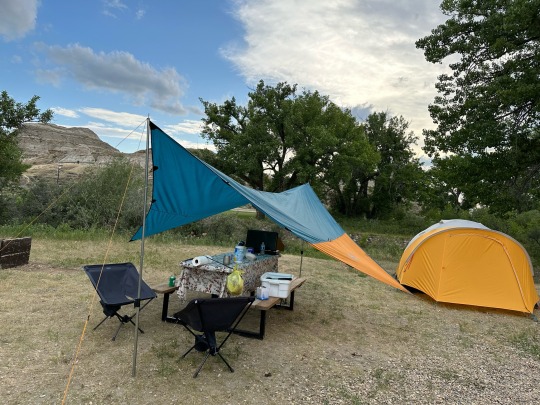
Our campsite.
Dino-trivia.
Another positive, the Canadians are really very friendly. We’ve spoken to several people, many noticed our NC tags (license plate). Our neighbor is a paleontologist who previously worked in the park, for example.
Asleep before sunset…
2 notes
·
View notes
Text
So many things have been found… I found out that writing everyday isn’t as easy as I thought it would be. I found out that British Columbia and Alberta are stunningly beautiful and the Canadians are delights, but I already knew that, Darlene being one of my favorite humans. After crossing the border into Canada we beelined it for Nelson, BC. I was there many years ago and it was almost as lovely as I remembered it. It turns out that everyone thought it was lovely 35 years ago and instead of a population of 5,000 it has closer to 20,000. We preferred the quaintness of Kaslo and met a Tai Chi instructor on the beach along the Kootney River that invited us to stay at her house the next time we pass through. We just may take her up on the offer. She didn’t give us her phone number though. Hmmmm…
We continued our way north and soaked at Ainsworth Hotsprings. It’s not Harbin, clothing is not optional (meaning you have to wear suits, not that you have to be naked~ you may have to be naked at Harbin?). I prefer the option, but it did have an amazing horseshoe cave filled with 104º water up to ones waist and stalactites and alcoves that you can sit in. Pretty amazing! We stayed at Mirror Lake Campground just beyond for a couple of nights, complete with a four month old Norwegian Forrest Cat that allowed me the opportunity for some much needed “Fuzz Therapy”. From there we headed to Nakusp Hotsprings and got caught in a thunder storm while we were soaking. I was tickled to see how nonchalant the Canadians were and tried my best to follow suit. There they were soaking away, being pelted by rain, big black rain cloud overhead. There we were, soaking with them, thunder rolling… finally a big bolt of lightening and everyone scurried out while one old guy said, “well at least it would be a quick death”. By the time we got back to our Clifford, the skies were clear and we were clean and happy.
From Nakusp we drove to yet another hot springs. This one was called Halcyon Hot springs. Very posh indeed. Four different pools of varying degrees of temperature from 60º to 85º to 98º to 105º all looking over the Columbia River. This is Canada’s Columbia River. I guess that guy “discovered” everywhere! It’s amazing how many towns and rivers are named after a wealthy banker, a contributor to the railway system, a “discoverer”. All men, all or most were wealthy. You know the story. We met a woman in one of the hot springs who was from Saskatoon and had worked as a teacher in the Arctic with indigenous “first people”. I mentioned some of the horrors in the US with the plights of our first people and thought that Canada seemed to honor their indigenous people with more grace and dignity. Sadly, apparently not the case.
From there we traveled northward, crossed the river on a little ferryboat and found a spot to camp at Blanket Creek Provincial Park. So far, knock wood (there’s plenty of that around), we’ve found a place to camp wherever we go. There’s either over flow camping sites or exclusively first come first serve campgrounds. We stayed one quick night in Monarch Campground, just on the border of Banff and Jasper. It was right on Hwy 1, Canada’s Trans Continental Highway. A couple of cars and trucks zoomed by in the night. Mostly we heard trains. So many trains all night long. I love trains, even in the middle of the night. And the views of the mountains all around at sunset were breathtaking. In the morning we headed to Lake Louise thinking that it would be one of the highlights of our trip. Quite underwhelming. Hordes of tourist buses, parking attendants flailing their arms in all directions trying to bring order to hordes of people trying to have a majestic experience next to a pristine lake, complete with a huge hotel with rooms costing between $500 and $1000+ per/night. Not my cup of nature. We drove in, parked, walked along the paved path, got our almost obligatory picture and left. Then we drove to Emerald Lake. Still lots of people and an expensive lodge, but exquisitely beautiful and much more up our alley. We headed toward Jasper, approached the National Forest Kiosk and now with our one year pass to any National Park in Canada hanging on our rear view mirror, we feel like we’re settling into the groove.
Have you ever sat and observed a few ants and how they meander about? They meet nose to nose, one goes to the left, the other to the right. Sometimes they climb over one another, but not often. They agree on who’s going to carry which end of a crumb and carry it somewhere together. They’re in a seemingly seamless groove. I feel a bit like them. Eddie and I are living in this tiny space. Our living room is about 4’X4’, our kitchen, den and bedroom are about the same and, oh, the living room, kitchen, den and bedroom are all the same room. Somehow we’ve established who moves in what direction while making our tea, brushing our teeth, dressing, cooking… And without talking about it we’ve established who does what. Eddie takes the bikes out and moves them to the back of Clifford, I pop the top and move all of our stuff (backpacks, bike helmets, laundry bag…) to the “loft”, Eddie takes the level and lifts out while I drive onto the lifts and he says when we’re level, We’ve got a routine going, but we never decided who’d do what. Good thing I’m traveling with my best friend and hubby.


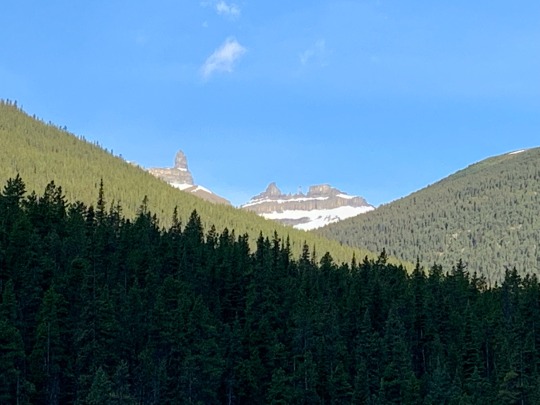

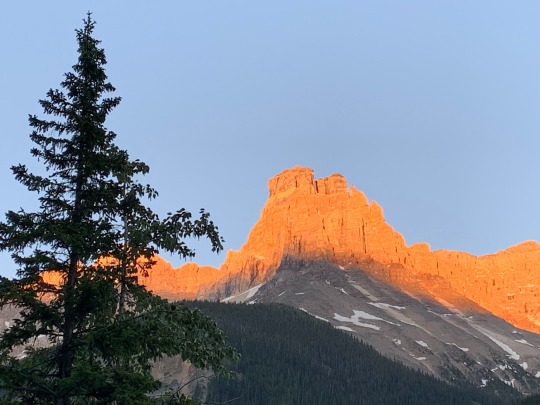
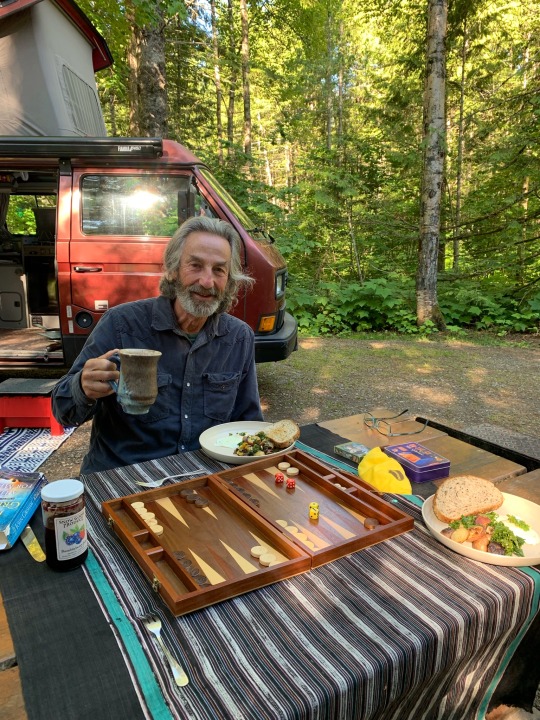


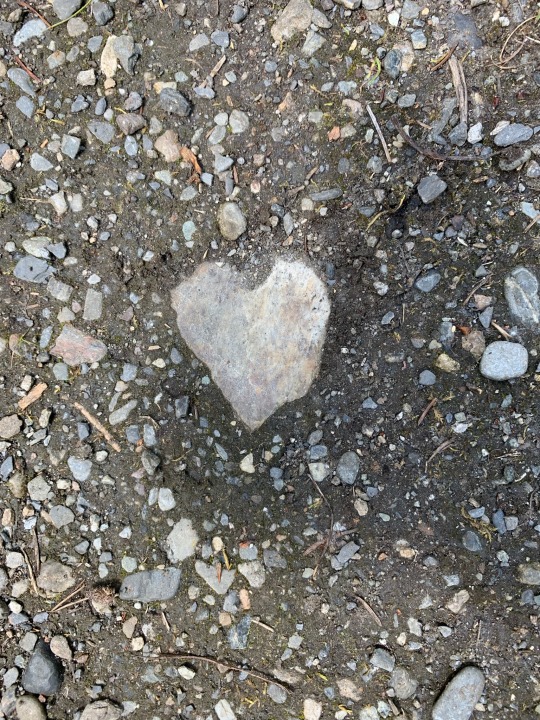
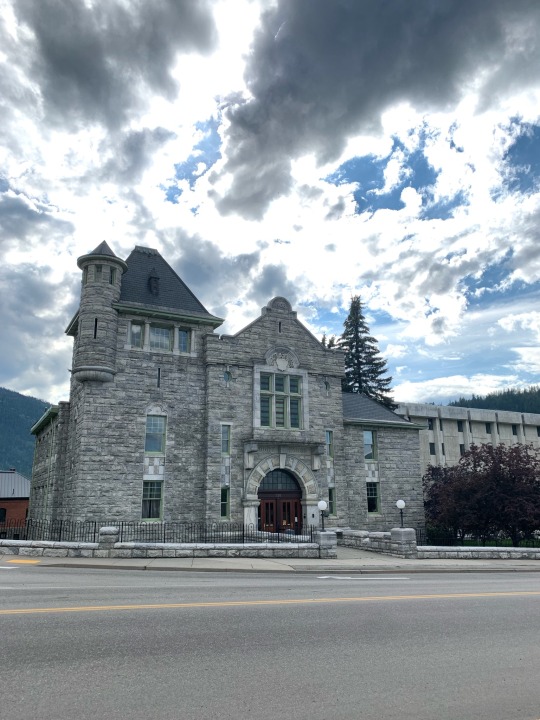
4 notes
·
View notes
Text
Greetings from Alberta’s Energy Transition Corridor, Canada’s unlikely green power hotspot
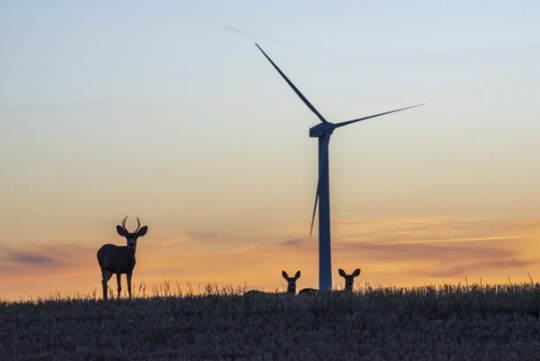
A wind turbine at sunset near the Transalta McBride Lake wind farm project near Ardenville, Alberta on October 4, 2022
Along scenic Highway 3, a multibillion-dollar renewables boom is transforming the energy landscape
As Grant Arnold strolled down the long rows of black and silver panels at his company’s solar farm near Burdett, a hamlet along Highway 3 in the south-eastern corner of Alberta, the October conditions could not have been more ideal for generating clean power. The sun beat down on the 72,500 south-facing solar panels, as a pair of miniature donkeys named Starsky and Hutch kept the facility’s groundskeepers – a herd of sheep – in line.
The Burdett Solar Farm is a new 20 megawatt facility developed by BluEarth Renewables Inc.[1], where Mr. Arnold is chief executive officer. Burdett and its sister facility, Yellow Lake, 20 km south, cover 85 hectares of farmland. BluEarth built them amid a massive influx of capital that has flowed into renewable energy along Highway 3.
These investments have made the province that’s long been known as the country’s fossil-fuel centre its green energy hot spot as well. Welcome to Alberta’s Energy Transition Corridor.
The highway cuts across a vast region that is reaping the benefits of famously bright and breezy conditions, a welcoming market for investors and big strides in green technology. Combine the space and the weather with provincial rules that allow power generators to sell directly to users, not just a government utility, and the corridor is uniquely well positioned. “It’s not happening anywhere else,” Mr. Arnold says.
Also called the Crowsnest Highway[2], the road starts at Medicine Hat in the southeast, then extends 324 km through Taber, Lethbridge, Fort Macleod and on past Pincher Creek in the Rocky Mountain foothills. From there it cuts through the Crowsnest Pass and continues west into British Columbia[3].
Along the route, signs of Alberta’s tried-and-true industrial lifeblood are everywhere – farming and ranching, food processing, cargo terminals, and oil and gas production. Day and night, heavy trucks trundle back and forth. Canadian Pacific Railway Ltd.’s tracks parallel the highway across the region’s rolling hills and badlands.
But transformation is also evident. The sunny and gusty southwestern corner of the province has been a hub for clean energy since the 1990s, and development is accelerating, with 17 projects generating 1,032 MW. Wind turbines by the hundreds poke up alongside the highway.
Lately, solar projects have popped up at a brisk pace, too. Many, like Burdett, are east of Lethbridge, developed by a variety of large and small companies. Provincewide, solar generation, at 1,088 MW, is now at the level the Alberta Electricity System Operator (AESO)[4] had forecast last year would not be reached until 2033.
Just five years ago, wind power accounted for 9 per cent of Alberta generation capacity, and solar didn’t even register, according to AESO. Today, the two sources make up 22 per cent. Solar alone is now 6 per cent of the total, and about to take its next leap when Canada’s largest solar project, Greengate Power Corp.[5]’s $700-million Travers development, starts up.
There’s also a nascent renewable natural gas (RNG) industry along Highway 3, in which the fuel is generated from agricultural and municipal waste, and plans for increased storage and other technology to level off the variable power supplies from wind and solar.
The former NDP[6] government kick-started development in 2016 with auctions in which wind developers bid on projects – those offering the least expensive power to the grid won. The arrangements have netted the Alberta government $160-million, according to new research by the University of Calgary School of Public Policy[7], and primed the pump for today’s investment rush.
“The number one driver of renewables in Alberta is private investment,” says Nagwan Al-Guneid, director of Business Renewables Centre-Canada (BRC)[8], a non-profit that provides education and networking services for developers, investors and electricity buyers. “These are private corporations, public institutions, looking to procure renewables through power purchase agreements in Alberta. They have serious ESG [environmental, social and governance] commitments.”
When BRC was established as an initiative of the Pembina Institute[9] three years ago, it set a daunting target of reaching 2 gigawatts of renewable energy contracted by 2025. Alberta has already surpassed that, after $3.75-billion in spending on new generation. All that activity, the organisation says, has created 4,500 jobs. Five deals have been signed this year, adding 333 MW of solar and wind power. More is on tap.
Green power is proliferating in other parts of the province as well. But Highway 3, already long established, can move workers and materials to and from projects quickly as they are constructed.
Most importantly, there’s “the resource” – sunshine and wind. Southern Alberta has both in spades. Lethbridge[10], for instance, averages 330 sunny days per year, or over 90 per cent of daytime hours. The region, known for its balmy Chinook winds that race across the Rockies, is also one of the breeziest in Canada, second only to St. John’s[11], according to Environment Canada. Lethbridge gets more windy days than any other city in the country.
The development has jolted local economies, which suffered with the downturn in oil and gas that began in 2014. Medicine Hat[12], known historically as The Gas City, has embraced renewables. Across southeastern Alberta, hotels are booked, restaurants are busy and the real estate market is strong, says Jon Sookocheff, economic development consultant with the city government.
Besides construction jobs, the industry is providing related opportunities, such as maintenance, warehousing and distribution. Colleges in the region are training the next generation of renewable energy technicians. “I think it’s one of the bigger development stories in Alberta and in Canada, and it’s maybe a bit of a secret right now. But it certainly takes a lot of work to put these production facilities into play,” Mr. Sookocheff says.
“All of a sudden there’s a renewables boom” for communities along Highway 3”, says Blake Shaffer, an assistant professor of economics at the University of Calgary, and a former electricity trader. “And they opened the doors to it.”
Source
JEFFREY JONES, Greetings from Alberta’s Energy Transition Corridor, Canada’s unlikely green power hotspot, in: THE GLOBE AND MAIL, 27/10/2022; https://www.theglobeandmail.com/business/article-alberta-energy-transition-corridor/
[1] BluEarth Renewables is active in select markets across Canada and the United States. Its growing portfolio of renewable energy facilities includes over 1 GW of nameplate capacity in operation, under construction, and contracted pre-construction, and over 5 GW of high-quality development projects that are actively being advanced. https://bluearthrenewables.com/
[2] The Crowsnest Highway is an east-west highway in British Columbia and Alberta, Canada. It stretches 1,161 km across the southern portions of both provinces, from Hope, British Columbia to Medicine Hat, Alberta, providing the shortest highway connection between the Lower Mainland and southeast Alberta through the Canadian Rockies. Mostly two-lane, the highway was officially designated in 1932, mainly following a mid-19th-century gold rush trail originally traced out by an engineer named Edgar Dewdney. It takes its name from the Crowsnest Pass, the location at which the highway crosses the Continental Divide between British Columbia and Alberta.
[3] In British Columbia, the Crowsnest Highway is entirely in mountainous regions and is also known as the Southern Trans-Provincial Highway. The first segment between the Trans-Canada Highway and Highway 5A is locally known as the Hope-Princeton Highway, and passes by the site of the Hope Slide. In Alberta, the terrain is initially mountainous, before smoothing to foothills and eventually generally flat prairie in the vicinity of Pincher Creek. The highway forms part of the Red Coat Trail and the CANAMEX Corridor from Highway 2 near Fort Macleod to Highway 4 in Lethbridge.
[4] The Alberta Electric System Operator, (AESO), is a not-for-profit entity responsible for the planning and operation of the Alberta Interconnected Electric System (AIES) in a "safe, reliable, and economical" manner. It is mandated by provincial legislation to act in the public interest and cannot own any transmission, distribution or generation assets.
[5] Greengate Power Corporation (Greengate) is a Canadian energy company focused on renewable energy in Alberta. Greengate's focus in the past was in large, utility scale wind projects and has recently developed solar projects.
[6] The New Democratic Party (NDP; French: Nouveau Parti démocratique, NPD) is a social democratic federal political party in Canada. The party was founded in 1961 by the Co-operative Commonwealth Federation (CCF) and the Canadian Labour Congress (CLC). On the political spectrum, the party sits to the left of the Liberal Party. The federal and provincial (or territorial) level NDPs are more integrated than other political parties in Canada, and have shared membership (except for the New Democratic Party of Quebec).
[7] The School of Public Policy is an institute at the University of Calgary located in Calgary, Alberta, Canada. Founded in 2008, The school is devoted to public policy research and education, and is led by Pierre-Gerlier Forest. Located at the University of Calgary’s downtown campus, it is home to over 60 full-time or part-time faculty and fellows. The school is organized into three policy areas: Economic and Social Policy, Energy and Environmental Policy, and International Policy. Since 2012 the school has offered a graduate degree program, the Master of Public Policy. The degree is structured as a 12-month program involving two semesters of classroom-based learning and one semester of project work.
[8] BRC-Canada is a community where buyers can learn how to source renewable energy directly from renewable energy project developers. Building on the successful experience of the Business Renewables Center in the U.S., BRC-Canada is a non-profit initiative seeking to catalyze the market for non-utility procurement in Canada to grow renewable energy development in the country. https://businessrenewables.ca/about
[9] The Pembina Institute is a Canadian think tank and registered charity focused on energy. Founded in 1985, the institute has offices in Calgary, Edmonton, Toronto, Ottawa, and Vancouver. The institute's mission is to "advance a prosperous clean energy future for Canada through credible policy solutions that support communities, the economy and a safe climate."
[10] Lethbridge is a city in the province of Alberta, Canada. With a population of 101,482 in its 2019 municipal census, Lethbridge became the fourth Alberta city to surpass 100,000 people. The nearby Canadian Rocky Mountains contribute to the city's warm summers, mild winters, and windy climate. Lethbridge lies southeast of Calgary on the Oldman River. Lethbridge is the commercial, financial, transportation and industrial centre of southern Alberta.
[11] St. John's is the capital and largest city of the Canadian province of Newfoundland and Labrador, located on the eastern tip of the Avalon Peninsula on the island of Newfoundland. The city spans 446.04 km2 and is the easternmost city in North America (excluding Greenland).
[12] Medicine Hat is a city in southeast Alberta, Canada. It is located along the South Saskatchewan River. It is approximately 169 km east of Lethbridge and 295 km southeast of Calgary. This city and the adjacent Town of Redcliff to the northwest are within Cypress County. Medicine Hat was the sixth-largest city in Alberta in 2016 with a population of 63,230. It is also the sunniest place in Canada according to Environment and Climate Change Canada, averaging 2,544 hours of sunshine a year.
0 notes
Text
Premier Doug Ford will take office on July 1st, promising to "get it done"--as the election slogan put it.
Ford and his Finance Minister Peter Bethlenfalvy if re-elected table the budget without any significant changes.
The budget for 2016-2017 was tepid at first but by 2018-2019 it had shifted dramatically--adding a $450 million promise that they had neglected to put in the budget.
The Alberta PC government has promised to cut the fuel tax by 5.7 cents per litre of gasoline, effective July 1st but only for six months. The loss of revenue for the provincial treasury during that period is estimated at $645 million.
Housing affordability was the issue named most frequently by a representative sample of Ontarians who responded to a CBC News civic engagement tool Vote Compass.
The plan will help keep costs down for families by "building the supply that meets home-ownership demand."
A re-elected Ontario PC government will build 1.5 million new homes over the next 10 years, the party says.
Doug Ford has pledged to get Highway 413 built in his home province of Ontario and it's hard to imagine he won't follow through on this promise. However, he has been deliberately vague on the cost and the timeline, buying himself some wiggle room on whether it comes in on time and on budget.
The Ontario Progressive Conservative government has kept its promise to build Highway 7 between Kitchener and Guelph, something it had already promised during the election campaign.
The timelines for when some of these will actually be built remain unclear, with some of the promises merely for the next phase of planning.
The Ontario government has pledged to create 30K new long-term care spaces by 2028. The bulk of them is to be constructed by the time the next election rolls around in June 2026. In April, the Ministry of Long-Term Care said the 365 projects now in the planning and construction pipeline exceed this target.
The government is promising tougher inspections of long-term care homes and stiffer fines for those that break the rules.
The Plan to Stay Open is part of the government's long-range blueprint for dealing with the post-Omicron phase of the COVID-19 pandemic.
The election platform commits to "hiring more nurses, doctors and personal support workers and keeping vaccines and other critical supplies in Ontario if elected.
The Ford government is directly linking the future of the electric vehicle industry in southern Ontario to the mineral-rich deposit in northern Ontario nicknamed the Ring of Fire. The region is said to have a supply of the critical minerals essential to the production of EV batteries.
Doug Ford has promised a $1-billion road to the Ring of Fire mineral deposit, something he had actually pledged back in 2018 to do even if he had to jop on that bulldozer myself."
The government has re-engaged on a promise to scrap the taxpayer-funded subsidy provided to political parties and extended it until 2024.
The amount provided to each party is based on the number of votes each received in the most recent election. The PC Party is in line to receive about $4.9 million in each of the next two years, at the current subsidy rate. The NDP and Liberals get about $2.8 million annually and the Green Party about $700K.
The government has repeatedly said it will hit its target for reducing greenhouse gas emissions by 30 percent from 2005 levels. In April, the government quietly revised its plan for how it will achieve this but is still forecasting success.
"We are going to make sure we keep every single promise," he told a news conference on election day.
0 notes
Text
A Review On Email Go Getter System (Eggs)
Have you seen those infomercials about buying houses with "No Money To?" They are really done well. They have all kinds of people offering great testimonials concerning how they have gotten rich, buying rental properties, with zero money out of their pocket. You check this out guy, standing on a street corner, discussing with someone, and he says, "I own that one," pointing to a beautiful colonial. "I also own that one next to it, and the one two doors down, and I'll be closing on one particular directly across the highway from it, thursday." He then assures us that he has purchased 17 homes in the last eight or ten months, with zero money down in regards to the properties. Plus, in stellaris gameplay latest download 's also paid no closing costs.
The letter "I" symbolizes Incentive. You must have something inciting in which action.your ultimate "Why". Just astroneer gameplay latest download doing what a person doing? The reason why you to be able to begin that business? A reason builds the cause that keeps you about your Phenomenon. No doubt regarding! But again, it is your responsibility decide what your incentive is and what will drive you toward your Miracle.
Soon, this became the norm, not the exemption. There were constant problems within houses. Unhappy tenants lead to poor repair off the property and considerably maintenance problem. About one year, after I amassed 26 houses, I was having problems with roughly 10-15 houses and/or tenants 1 week. I was evicting about two tenants each month, and approximately four to seven tenants were either behind on rent or paying at all. Promises were made, payment plans arranged and few, if any, ever followed through.
As well, each province and territory has the rules. Ontario charges 8 % retail sales tax on many typical Internet transactions whereas Alberta doesn't have a provincial sales tax.
In many this unpleasant method is permanent. It would possibly be excruciating. Also it could possibly be crackeygenpatch expensive centered on the dimensions the area to be treated. f1 2017 crack pc game download up being important to obtain professional treatment to avoid skin damage. Results: Permanent.
As customer is required to spread their legs a number of embarrassing positions, acting in a matter of fact way, treating because normal, assistance a person feel a little less self-conscious. Remember, that's how the aesthetician views it.
And have you considered the incident in Orange County, CA where the performer constitutes a comment about Linda Ronstadt and audience starts booing and the performer responds with how America were previously a place where you may openly discuss your views. Ha! Twenty thousand people and he's the just one with a microphone! Open discussion, my ass.
1 note
·
View note
Text
All The Comforts Of Home - Or Home Business Office!
What is it with these performers and their politics? Do they really think that people who pay $100 or more to hear them sing want to hear them utter political opinions? The crowd pays hundreds of thousands of dollars to see and hear a performer PERFORM. You to be able to spout politics, run for freakin office, you moron! When performers use a paid venue perform politics they are abusing the paying audience, the venue, the sponsors and everyone connected for his or her artistic performance. 4k stogram crack license key 's an inappropriate venue and inapproprite behavior to voice your political viewpoint, you jerk! And they wonder individuals boo.
Tip: Do a search for narrowly defined niche markets where goods or service solves a wonderful need within the customers. Focus your marketing on them instead attempting to reach a broadly defined general market. You'll generate more sales and get a better return upon your advertising tremendous cost.
Keep the shaven area well moisturized between shaves by employing a skin moisturizer or baby lotion. Foods reduce the uncomfortable effect the stubble may cause between shaves.
As well, each province and territory has an rules. Ontario charges eight percent retail sales tax on many typical Internet transactions whereas Alberta does not have a provincial florida sales tax.
Items that lack certain qualities could be ruined by attempts to engrave him or her. Many items today are not solid metal but are cast within an inexpensive alloy and plated finish. In many instances quality plating can survive some engraving processes activatedlink but more often zilch the plating will peal or allow corrosion under the engraving causing severe problems down the highway.
If pain is a primary concern use a pain reducing gel or cream you can purchase pharmacists. These solutions must be applied 30 to 1 hour before waxing so skin is numbed beforehand.
Tweezers are perfect for isolated hairs and some facial types. It is an inexpensive method of hair removal although top quality tweezers are expected. Results: From 3 to 8 weeks.
Waxing traditional hair removal is fast and inexpensive. Some waxes can impact the skin treatment. It may be painful depending on the person's toleration level. Results: From 3-6 weeks.
1 note
·
View note
Text
23 June 2020: Formal challenge to Alberta’s “anti-protesting” law, which came into legal effect 17 June 2020, apparently targets blockades, and could potentially criminalize demonstrating on public streets, bridges, etc.

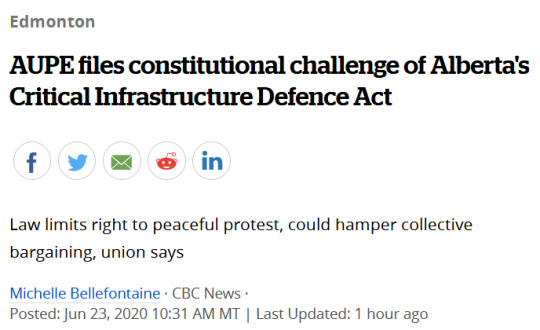
Excerpt:
Alberta's largest public sector union is challenging new provincial legislation enacted to prevent rail and road blockades.
The Alberta Union of Provincial Employees says the Critical Infrastructure Defence Act, which came into force on June 17, violates the rights of Albertans to peaceful protest and will hamper the union's ability to engage in collective bargaining, which includes the right to strike. The union is filing a statement of claim in Edmonton Court of Queen's Bench Tuesday morning.
"We will fight this all the way to the Supreme Court and we will defend any and all AUPE members or staff who are caught in the bill's crosshairs," AUPE president Guy Smith said in a news release Tuesday.
Bill 1 was introduced by the United Conservative government in February in response to the blockades of CN rail lines by Indigenous protesters earlier this year.
The bill levies hefty fines against individuals or companies found to have blocked, damaged or illegally entered any "essential infrastructure" including pipelines, rail lines, highways, oil sites, telecommunications equipment, radio towers, electrical lines, dams and farms.
Fines for individuals are up to $25,000 a day and up to six months in jail; corporations found to have violated the legislation face a daily penalty of up to $200,000.
Critics say the vagueness of the legislation mean people on public land, walking down a highway or next to a railway could potentially face fines. [...]
Jonah Mozeson, press secretary for Justice Minister Doug Schweitzer, said the bill came in response to the blockades that halted rail traffic across the country.
"Bill 1 is clearly aimed at those who would block key infrastructure such as railways, bridges, pipelines, and highways," he said in a written statement.
---
267 notes
·
View notes
Text
X CANADA
Day 1- Bigbird’s big adventure began by driving from Kelowna to Red Deer to dump off the mutts and say adios to the family

Day 2- We made a mile and left Alberta towards Saskatchewan. All the crops had just been harvested and the wide open fields held only hay bails, cows and the odd herd of antelope.
We spent the evening in Cypress Hills provincial park which was a random spot amidst the praries full of trees and a body of water. We went to bed early and hit the road earlier to keep on rollin
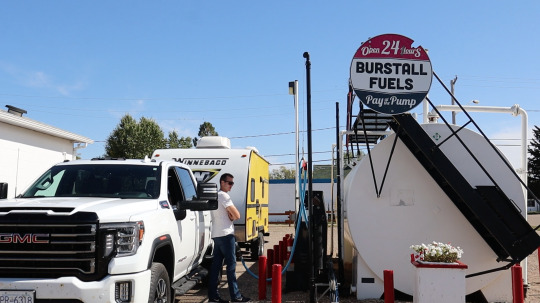
Day 3/4- We breezed into Manitoba and stayed at the Kiche Manitou campground. We woke early enough to be one of the first to arrive at the Spruce Woods Provincial park.
The Spirit Sands was a 10km hike with a mixture of elements- one minute we were in the prairies surrounded by flat land and crops, the next we were in a forest of mixed vegetation and sand dunes.
Unlike an arid desert, these sand dunes were full of life; Big gross white spiders (the wolf spider) , grasshoppers, yellow daisy like flowers, and oddly enough mushrooms growing out of the sand.
After emptying the sand out of my shoes 5 times, the land transitioned into prairies mixed with forest and water features.
Further down in the Devils Punch Bowl area was a beautiful blue green body of water with trees growing in and around it and Skink lizards swimming around.
By the time we finished the hikes and got back to the camper, the parking was completely full so we hopped back on the road
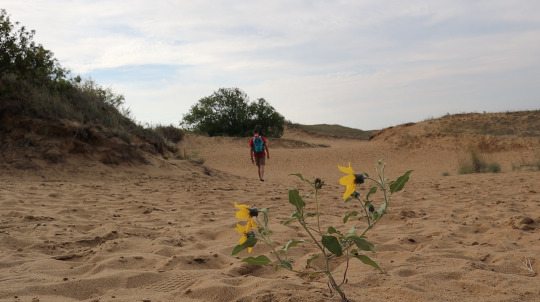
Day 5- we spent the day driving and made it into Ontario. We stopped and had a crispy charcoal pizza in the parking lot of an abandoned restaurant. The skies poured their hearts out as we drove into the night and ended up spending the evening in a gas station parking lot.
Day 6- truckers began peeling out and the sound of the crosswinds and rain woke us. The rain come down faster than the wipers could clear it. We drove down the highway, a crimson red, coloured from dirt here.
Out on the horizon was a light blue lake smashing against the cliffs of Canadian Shield . Things settled long enough for us to enjoy an extremely windy sunset at Lake Superior Provincial Park. Our campsite backed onto a long stretch of beach with soft sand and red rocks. If you didn’t know it was a lake looking out, you’d think you were at the ocean. Darkness fell quick and the next morning we went for a quick hike at Cresent Lake. We drove all day and had our first overnighter in a Walmart parking lot
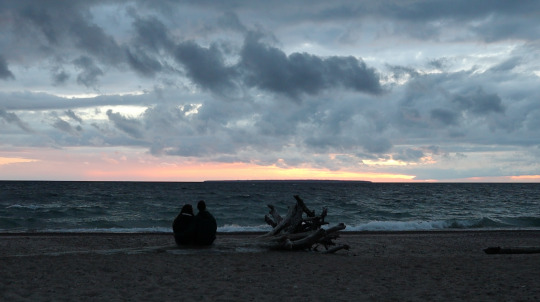
Day 7- We made it into Ottawa and stayed at the Wesley Clover campground, only 15 minutes from downtown and close to IKEA (which we had to visit).
For the first time this trip we set an alarm and not only did we get our oil changed, but we got a free breakfast!
All lubed up we went and parked the truck downtown for the day. Unfortunately because of covid, all the things we planned on seeing were closed and under construction. We walked around the parliament building, majors hill park, notre dame basilica and admired the outside of the buildings.
The centennial flame had an odd presence to it- due to the findings of the children at the residential schools there were shoes, teddies and protestors surrounding the area.
We got some Mexican food for lunch and tried eating outside, but a swarm of wasps joined us and had to taste everything including our beverages. After a small freak out, we got our bikes and toured further around downtown. We biked down the Rideau Canal and over many bridges.
After getting slightly lost we went back to the camper and had lasagna for dinner.
Homeless Guy-“What games do you play?” Kaine-“ I don’t play video games” Homeless Guy -“hahahhahaha cool guy doesn’t play video games! Yeah right hahahhahah”
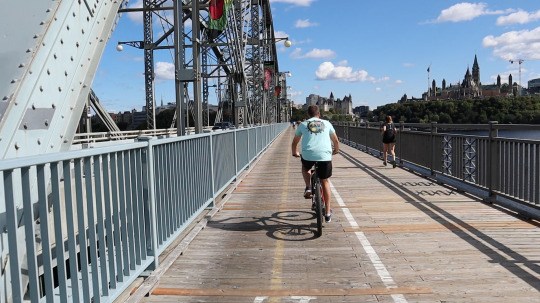
Day 8/9- the morning started off slow with some laundry and driving, but we made our way to the eastern townships and found a cute little family owned campsite called Camping Leroux.
Hélene greeted us and was the first person to hold a full conversation with me in French and not switch to English. *accomplishment*
We drove into a close by town called Magog and, as recommended to us, had poutine at Chez Paul. We watched the sun set from atop a light house then got some groceries and headed back. The following morning we set off to Mount-Orford and did a 10km loop. There isn’t much soil on top of the rocks for the trees to grow, so instead of growing into the ground, the routes splay outwards throughout the path weaving over each other.
Afterwards we drove to a parking lot in a nearby town called Sherbrooke. The steepest hill in town just so happened to be their Main Street, so we peddled our bikes as hard as we could up it then coasted along the river. We ended up biking to a basilica in town and toured the inside where the sun was casting beautiful rainbows throughout the church. To cap off the day we went paddleboarding at sunset, made tacos and had a little fire.

Day 10-We drove into Quebec City and parked near the old downtown area. The buildings were all colourful and full of small details making each one unique. There was some interesting art Installations throughout the streets- like a woman on a swing 20ft in the air between buildings or a guy fishing over a stream..
The next morning before leaving we did a 6km run around the lake then cooled off with a quick paddle board. We made our way to Quebec City where we stayed at a campground called Quebec En Ville. The woman running it didn’t speak any English so I got to really test out my French speaking abilities. Our google maps also decided (on its own) it would develop a French accent while here.
There was a long boardwalk which looked out onto the Saint Lawrence river and a staircase which claimed to have 310 stairs. It didn’t look like 310 so I counted them as we went up and low and behold there was more. Liars.
Most of the shops seemed gimmicky and like a tourist trap, so we avoided them and went out for lunch. While enjoying our escargot on the patio, we had front row seats to a guy playing a game where you swing a metal ring on a string onto a hook. Very mindless, but entertaining. After lunch we took a tour through the citadelle, but learned very little as our tour guide was very hard to understand hah. We took a short bike ride after and shared a crepe before heading back to camp.

Day 11- After sleeping in and driving all day and night, we arrived at the Bay Of Fundy and stayed at Headquarters campground. The next morning we hopped in the truck and drove to a nearby hike called Matthews Head. It was a very humid 4.7km hike with a couple viewpoints, an array of colourful mushrooms, and tons of squirrels who’d throw things at us from up in the trees. We then drove up to a lighthouse lookout called Enraged Cove and met a few locals who gave us a fossil and pointed out a cluster of red ticks in the bush. We continued on to Hopewell Rocks when the tide was at its lowest and walked the sea bed scavenging for critters. We found one small crab, but he dead.

Day 12- we drove over the confederation bridge and made it into PEI! (Not before a quick nasal swab upon entry) We stopped for a quick burger and flight of beers at Lone Oak Brewing (the beer wasn’t great but they had nice merch, so we got a hoodie) then went to our campsite in Cavendish.
The following day we went into Charlottetown to stuff our mouth holes full of muscles, seafood soup, lobster rolls and bruschetta. We waddled back to the truck and went back to the campsite because I was too full to keep walking around. We stuffed ourselves into our swimsuits and spent the evening relaxing on the beach.
Not too far from the beach was a trail we ran each morning to a lookout point. The first thing you would run past was chipmunks and rabbits eating apples that had fallen onto the ground, next was red sand dunes blown up from the beach, followed by a fishing pond then the lookout.

Day 14- we’d been eating lots of pasta so we decided to do the hardest hike we could find nearby. We chose one called Franey Trail which led us up to a 360 view of Clyburn Brook canyon and the Atlantic coastline from Cape Smokey to Ingonish. We had a little picnic at the top then hiked back down to a second hike. After a quick hotdog we hiked the Middle Head Trail which had the windiest damn lookouts I’ve ever been too. We hiked out and made our way to a nearby beach and watched the waves roll in until we headed back to camp for the evening.

Day 15- we made it across Canada! Alas, it was time to turn around. We drove for a bit and stopped for lunch in Antigonish NS, at a place called Brownstone restaurant. I picked it because it had a cute old style store front, and for the same reason, tourism Nova Scotia was there filming a tourism commercial.
Next thing you know, we’re signing release forms and part of the shoot! We ordered clam chowder, salad and a maple bacon poutine to share. The poutine was the best we’ve had. A few local beers and we were back on the road until dark.
Days last- we drove and drove and drove. We had a Walmart sleepover again one eve, drove over a damn and set up in the pitch dark on a hill at Mactaquack NB, had a sleep over Selkirk Manitoba and had a frog in our site, had a river front stall in River Park Sask and had an evening paddle board with a beaver.
3 notes
·
View notes
Video
Mount Cory Along the Trans-Canada Highway 1 (Banff National Park) by Mark Stevens
Via Flickr:
Okay, I admit it. When I pulled off the highway to take this image, I was drawn in to this mountain view with the Bow River flowing by and the hillsides of trees with the blue skies and puffy white clouds. It was only later when I looked it up and checked the direction/azimuth that I noticed that it was Mount Cory with the Hole in the Wall.
#Alberta Highway 1#Alberta Provincial Highway No. 1#Banff National Park#Blue Skies with Clouds#Bow River#Canadian Rockies#Capture NX2 Edited#Central Front Ranges#Color Efex Pro#Day 2#Evergreens#Hillside#Hillside of Trees#Hole in the Wall#Hole in the Wall Mountain#Looking East#Mount Cory#Mountain#Mountains in Distance#Mountains off in Distance#Nature#Nikon D800E#Portfolio#Project365#River#Roadside Pulloff#Sawback Range#Sawback-Slate Ranges#Trans-Canada Highway#Trans-Canada Highway 1
7 notes
·
View notes
Text
For the first time since New Year’s Day, Grande Prairie MLA Tracy Allard has issued a public statement, after it was discovered she had travelled to Hawaii in December amid ongoing public health restrictions and advisories against non-essential travel.
Allard’s statement comes in the form of a letter to her constituents, where she apologized for her decision to travel. She adds in conversation with constituents, she feels the overwhelming thing she is hearing is to “to move on and refocus on the important work of the constituency.” The letter, in its entirety, can be seen below.
Dear Constituent,
As we get into the fourth week of 2021, I recognize the challenging start to the year and I wanted to reach out directly. Many of you have contacted my office regarding my decision to travel over Christmas and your frustration over the year of Covid restrictions. I understand and hear your anger, and I am truly sorry for any hurt and frustration my actions have caused you, particularly as I think of the many sacrifices you have made during the last year.
Since my apology earlier this month, I’ve spoken to many constituents and hear a growing sentiment to move on and refocus on the important work of the constituency. I am committed to doing so and have continued to work on behalf of constituents throughout these last weeks. I am honoured to serve the City of Grande Prairie as your provincial representative and remain committed to serve through continued hard work and community engagement.
At the start of the pandemic, I had posted regular updates on social media in an effort to keep you informed as we faced the uncertainty of the time and I will be doing that again for this season with a focus on pandemic response, in particular vaccine rollout and Alberta’s Recovery Plan.
Alberta is consistently leading all major provinces for the roll-out of the COVID-19 vaccine, with over 92,000 doses of the vaccine already administered to Albertans. We have ensured that enough vaccine is available so we are able to provide second doses to all long-term care and designated supportive living residents. Canadian provinces are dependent on the Government of Canada for vaccine supply and we are prepared to vaccinate many more Albertans daily as supply arrives.
I often speak about hope for brighter days ahead and I have personally found it helpful in times of trouble to look beyond my current circumstance to future opportunities. I want to highlight two priorities that represent good news for Grande Prairie:
The new Grande Prairie Regional Hospital will be opening this year at long last.
The twinning of key sections of Highway 40, including the bridge, will begin this spring.
The pandemic has highlighted the need for us to care for one another in community. We witnessed the generosity of the Grande Prairie community during the Salvation Army’s Annual Christmas Kettle Campaign. This successful campaign exceeded their goal, raising over $750,000, with funds going directly to assist families in the Peace Region.
Two additional initiatives of note:
The expansion of the Small and Medium Enterprise Relaunch Grant will allow new businesses that began operating between March 1 and Oct. 31, 2020 to apply for supports, creating eligibility for support to 5,000 more Alberta businesses.
Nominations are now open for membership into the Alberta Order of Excellence. If you know a remarkable Albertan from your community who should be considered for membership, please consider submitting a nomination. Applications must be submitted Feb 15, 2020.
I look forward to serving you in the future as we look for better in 2021.
Sincerely,
Tracy Allard, MLA
18 notes
·
View notes
Text
Chapter 4: Day Job - Easter Eggs
Hello again and welcome, if you read and enjoyed Chapter 4 of Battle of Alberta but wanted a closer look at some of the stuff I referenced or incorporated, links to more information, or just an explanation of my thought processes, you’re in the right place. Feel free to reply to this post or shoot me a message with any questions you have about this chapter I could add.
Page 1
Hello Calgary is a song that was stuck in my head for weeks after I decided to use it as Calvin’s alarm! I linked to the version I had stuck in my head (which is also the version used for the intro to the Alberta Advantage Podcast), but there’s tons of other versions. It’s not only Calgary’s song, it was actually written for hundreds of American cities, but Calgary seemed to take a particular shine to the song that really stuck.
Howdy is one of the two Olympic mascots for the 1988 Calgary Winter Olympics. Calgary was the first city to use two mascots for the Olympics; Howdy and Hidy welcomed people to the city with good old fashioned Western hospitality... I read a piece from 2007 quoting councilors on the decision to remove them from the city’s welcome signs saying something to the effect of “it’s time Calgary outgrew them!” which is pretty sad... obviously Calvin hates to let go of things.
Page 2
Calvin’s apartment is based on the Keynote Penthouse in downtown Calgary, which is just as ridiculous as i draw it. In fact, it’s MORE ridiculous in the photos.
His socks aren’t real but based on the Calgary flag, which literally has a cowboy hat on it. Because.
Page 3
Bankers Hall on the left side of the first panel is part of two twin towers in downtown Calgary designed to resemble cowboy hats on top. I wish I were making this up.
The Calgary Tower was built in the 70s to be the tallest building in the city by Husk- er, uh, “Malamute” Energy. It was surpassed at almost breakneck speeds by the rest of the skyline. And it shoots fire sometimes because of course it does.
Page 4
I would NEVER put real people in the background of my comics, especially not caricatures of infamous prime ministers. Don’t @ me.
The firm handshake thing is dedicated to an ad for a certain business school in calgary that i saw all over the airport one time when I was there that I can’t recall at the moment.
On that note: the western overlay on his business talk is also real. A few months ago in a class I took, a guest speaker mentioned that a “gentleman’s handshake” was still an acceptable form of contract in Calgary, shivered, and said “no thank you”. I was laughing so hard internally I also choked internally.
Page 7
The Lethbridge viaduct which is symbolic of the city is confusingly also named the High Level Bridge, which as an Edmontonian annoys me, but I begrudgingly admit that Lethbridge’s was first.
Page 8
Lethbridge recently surpassed Red Deer as the third biggest city by population, which is still tiny at about 1/8th-1/10th the size of Edmonton or Calgary. They say “no hard feelings” since they often switch back and forth in this role, although since recent cuts to post secondary on top of a pandemic it is unlikely that RDC will be a fully fledged university anytime soon.
Ed’s weird socialist agenda faces only minor setbacks. He’s allowed to elect people too, you know.
Page 9
For the love of god LEAVE YOUR CLIPPINGS ON THE LAWN!
I just assume Lilith enjoys ikebana for reasons
Page 10
okay ngl Amazing Race Canada 2019 (Season 7) was the best season and I’m not just saying that because I’m biased towards my team. They did ikebana in the Edmonton episode and my heart...
Astounding Trek is what they refer to it as in Kim’s Convenience (S03E11)
Seriously my team is the best team do NOT @ me.
Page 11
I believe the beer in panel one is from Coulee Brew Co. This is more for local colour than for endorsement, I don’t drink so you’ll have to tell me if it’s any good.
For non-Canadians or for Canadians who missed my subtle dragging, I am referencing Prime Minister Justin Trudeau (who said the quote) and outgoing Conservative Party Leader Andrew Scheer (who recently got into a scandal about pretending to be an insurance broker when he was not qualified).
This comic took place before the federal election of October 2019, where Justin Trudeau scraped by with a sobering minority government. Many people across the country are frustrated with Trudeau for different (and evolving) reasons, but he is particularly hated in western Canada and especially Alberta for qualities including his perceived weakness and his poor efforts to ‘compromise’ on such projects as the Keystone XL pipeline.
Personally, I don’t agree with many reasons that people in Alberta hate him, but I still have a lot of reasons to hate him anyway. He’s not the woke bae you think he is, and he is a coward. However, thats not the point of this comic.
Page 12
The cartoon Calvin is watching is an episode of Dudley Do-Right. I made the horrible mistake of re-watching the live action version after drawing this. It was Bad with no redeeming qualities beyond Brendan Fraser’s face.
The 60s were a hip and happening time in Canada on a national level: apart from the threat of nuclear war, we were busy beavers celebrating the country’s centennial and the world expo in Montreal. Provincial leaders started meeting with each other for the first time, bilingualism and multiculturalism were making headlines, and the Socreds (Social Credit Party) were in the middle of their almost dynastic reign in Alberta.
Page 13
Fort McMurray is connected to the rest of the world either by air or by a highway which is so prone to danger and bottle necking that it is nicknamed the Highway of Death. Edmonton is the most major destination at the end of this highway, and thus Mac is quite used to crashing at Ed’s place when things go south (which seems to be an awful lot.) He’s happy for access to cheap beer.
Page 14
This is Patches’ first appearance in the main storyline. He is a rescue slash emotional support dog and a malamute/husky/??? mix. Mac pretends he’s a guard dog but he really only guards Mac’s brain.
Mac picks up a lot of east coast slang, ‘darts’ for cigarettes being one example.
The take-out packages are the kids boxes from Oodle Noodle... many fond memories of getting take out with my friends from there ;u;
Page 17
The nostalgia panel is full of Edmonton memorabilia including: A Klondike Days flag, a photo of young Wayne Gretzky, old and proposed city flags, a flag for the CFL team (which I deliberately drew backwards), a redesigned Oilers logo from the mid aughts, and of course the Alberta flag in the center. Many of these items have colonial/racist baggage associated with them.
Page 22
Panel one is a delicious shot of some green onion cakes, the unofficial civic food of Edmonton.
Vulcan Ale is indeed a real thing you can buy with your money - it’s an American beer from Montana but available in western Canada. See also the Federation of Beer based in Alberta... we are a province of Trekkies (although if you ask Ed, he actually prefers Star Wars)
Page 23
Pizza 73 is just whatever the worst generic pizza chain in your area is but for Alberta (Eastern Canadians, think Pizza Pizza).
That’s all for now folks!
4 notes
·
View notes
Text
Not exaggerating, I do feel like I’m an involuntary witness to some kind of fantastical, horrific, and yet comedic fever dream. The hubris, the catastrophic failure in Alberta’s oil fields, and the cascading effects of Alberta’s actions, significantly altering the course of fossil fuel industries, Indigenous land management, and pipeline resistance at multiple pipeline and extraction sites across all of North America, all happening within only one month of time.
Early 2020: The value of a barrel of Alberta oil is now worth less than a single bottle of maple syrup.
24 February 2020: Even before pandemic quarantines become universal, headlines around the world ask: “Is this the end of the era of Alberta’s Tar Sands?” This is in response to the “death’ of the 21-billion-dollar Frontier project.” After 9 whole years of negotiation, a potential deal between Trudeau and a major energy company collapses. The Frontier project would have increased Canada’s oil production by 5% and caused devegetation of at least 25,000 acres of boreal forest. The deal involved Canadian federal approval of a T/e/c/k Resources project which would depend on the construction of the Keystone XL pipeline. T/e/c/k lost hundreds of millions of dollars in paying out-of-pocket for a regulatory review. In recent months, multiple global oil giants, including R/oyal D/utch S/hell and Con/ocoPhil/lips, announced they were ending investment in Alberta’s Tar Sands.
30 March 2020: Pandemic quarantines lead to operation closures in Alberta’s Tar Sands. Now, you could probably buy 2 barrels of Alberta oil for the price of 1 bottle of maple syrup.
31 March 2020: Regardless of nearly-worthless value of Alberta oil, and while Alberta recently reports a staggering 14 billion dollar deficit as pandemic spreads, on this day Alberta premier Jason Kenney announces that Alberta will donate over 7 billion dollars in investments and loan guarantees to the Keystone XL pipeline project designed to export oil from Alberta’s Tar Sands and into the Great Plains of the US. The portion of Keystone XL that needs to be built within US borders had been legally suspended since 2012, but revived by the US government in January 2020.
2 April 2020: Less than 3 days since the Alberta provincial government granted billions to Keystone XL, on this day, Athabasca Oil Corp. is forced to end their operations at the Tar Sands, also cutting their corporate staff by 15%. Over the past week, Alberta energy titan Sun/cor was forced to close one of its two oil lines at Fort Hills, potentially diminishing processing of 50,000 barrels of oil each day. On this day, Global News Canada also reports that most Alberta energy companies have lost 20% to 50% of their staff and cut their executive member salaries by 10%. Canadian energy companies cut $6 billion in expenditures in March, about 30% of oil operations. Canadian oil companies have cut output by over 100,000 barrels each day since pandemic arrived in North America.
Bonus round, extra news from 2 April 2020: The Sault Ste. Marie Tribe of Chippewa Indians and Bay Mills Indian Community, among other tribal communities, challenge the Michigan Public Service Commission during public comment sessions, asking Michigan to deny En/bridge Energy’s Great Lakes Tunnel Project. In the midst of pandemic, En/bridge said it would not delay submitting permits to build the tunnel. The project would service En/bridge’s Line 5 pipeline, which brings oil and natural gas from Superior (Wisconsin) to Sarnia (Ontario). It is expected that Michigan will make a decision on the permits within 1 to 4 months.
5 April 2020: On 3 March 2020, En/bridge Energy, based in Alberta, announced that the completion of their Minnesota pipeline might be delayed for a year. But then pandemic happened. On this day, the Minneapolis Star-Tribune reports that Alberta’s Tar Sands difficulties might yet be directly responsible for giving activists and Minnesota Public Utilities Commission good reason to finally end the construction of En/bridge’s $2.6-billion Line 3 fossil fuel pipeline in Minnesota. En/bridge had expected the Minnesota pipeline to be operational by the end of 2020.
6 April 2020: After waiting nearly a decade to build the infrastructure, the construction of the US portion of the Keystone XL pipeline finally begins on this day, at the border between Montana and Saskatchewan, as pipeline workers move into region despite how most people on Earth are told to stay indoors and not to travel. The Fort Belknap Indian Community, located close to this pipeline construction site, declares a state of emergency in response. Tar Sands operations in Alberta have lost billions of dollars in income in the past 3 weeks.
16 April 2020: Less than only 3 weeks since Premier Kenney announced Alberta’s donation of billions of dollars to Keystone XL, and only 10 days after the Keystone XL pipeline began construction, Native organizers from Rosebud Sioux reservation (South Dakota) and Fort Belknap Indian Community (Montana) convince a judge in a small Montana city to legally halt construction on important portions of the pipeline, citing the pipeline’s potential harm to the American burrowing beetle in Nebraska’s Sand Hills and riparian species like the pallid sturgeon.
20 April 2020: The value of oil drops below $0.00 for the first time in history.
Bonus round, extra news from 20 April 2020: As a result of the Montana ruling against Keystone XL, the US Army Corps of Engineers announces that dozens, or perhaps hundreds, of fossil fuel projects in the US must be immediately halted and reevaluated, since thousands of fossil fuel projects were inadequately assessed for ecological effects since 2017. The Permian Highway pipeline in Texas and the Mountain Valley pipeline in Virginia are also expected to be delayed, costing multiple oil/fossil fuel companies across the US millions/billions of dollars.
24 April 2020: Alberta’s highest court overturns prior approval from Alberta Energy Regulator and crushes a 440-million-dollar Tar Sands project in the Moose Lake region north of Fort McMurray, only weeks before the oil operation was set to begin construction, ruling in favor of the Fort McKay First Nation who successfully sought to protect a portion of their land considered sacred. Over 70% of Fort McKay First Nation’s land is already taken by mines.
27 April 2020: 3 of the biggest Alberta energy companies report combined $4.8 billion in losses. Premier Kenney says he’s been told that Alberta will be liable for oversupply of worthless oil for at least 12-18 months.
1 May 2020: The developers of Keystone XL announce that the Montana court ruling might suspend the completion of their pipeline for over a year. US corporations and monitors of energy industries continue to say that the ruling’s effects “are hard to overstate” and are “a big deal,” which could cause legal challenges that would prevent pipeline construction for years and lead to bankruptcies.
---
Alberta ...
264 notes
·
View notes
Video
Honda CR-V (2015) by Mark Stevens
Via Flickr:
I got the idea for this image from this Flickr image (www.flickr.com/photos/kagirohi/11854685244/in/gallery-147...). I'd been looking here and there for times I might capture a similar type image with the inside of a car. I hoped to be able to catch something where the light was coming in from the other side as it crossed the dashboard of a car. So there I was enjoying a ride along the Trans-Canada Highway 1 when I got out for a view of mountains. After getting back in the car, I finally noticed the inside dashboard view and capture this image.
#Alberta Highway 1#Alberta Provincial Highway No. 1#Banff National Park#Capture NX2 Edited#Color Efex Pro#Dashboard#Day 2#Honda#Honda CR-V#Inside Car#Instrument Panel#Looking SW#Miscellaneous#Nikon D800E#Project365#Roadside Pulloff#Steering Wheel#Trans-Canada Highway#Trans-Canada Highway 1#Alberta#Canada#flickr
2 notes
·
View notes
Text
Almost three years after tens of thousands of Fort McMurray residents scrambled down a single choked highway to escape a monstrous wildfire, NDP Leader Rachel Notley promised her government would push ahead on a second route out of the northern city if re-elected.
Notley rolled out the promise Wednesday during a campaign stop in Fort McMurray, where she also laid out a $1.35-billion plan to expand the Alberta high-load corridor over the next six years.
“It was one of the scariest moments in many people’s lives, but folks made it through because they stuck together,” Notley said of the wildfire evacuation, which saw every vehicle forced onto the existing Highway 63 to escape. “We know Fort McMurray needs a second route out.”
The province previously invested $5 million for pre-design into the East Clearwater Highway project, which the Regional Municipality of Wood Buffalo endorsed in 2016 as a new evacuation route for all communities between Anzac and Fort McKay.
Notley, who noted the next phase in that project involves community consultations, didn’t confirm that would be the route or what funding would be needed.
The high-load corridor is a 6,500-kilometre network of roads across the province that can accommodate heavy vehicles weighing up to 800 tonnes, and up to 12.8 metres tall. Notley’s plan would expand the network by 3,500 kilometres.
“That high-load corridor gives Alberta a distinct competitive advantage,” she said. “We will ensure that Alberta’s highways are prepared to handle the increase in movement of large equipment and fabricated components related to the growth in petrochemical upgrading and refining sectors.”
A study conducted by the provincial government and released in January recommended a $1.6-billion infusion to upgrade the corridor.
Continue reading
25 notes
·
View notes


